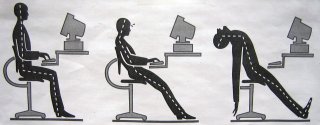Ever felt that tension in your upper back and neck after sitting at a computer for too long? We’ve all been there – and resented going to sit at another desk for it. That’s where ergonomics comes in. And your cleanroom’s ergonomics matter just as much as any other workplace.
What Are Ergonomics?
According to Human Scale, ergonomics is “defined as the science of fitting a workplace to the user’s needs, [it] aims to increase efficiency and productivity and reduce discomfort.”
When it comes to cleanrooms, we talk a lot about keeping them clean, reducing particles, improving workflow, etc., but we often forget about the human aspect.
At least, outside of a person’s tendency to shed particles through skin and clothing.
But the reality is that a cleanroom is usually a workspace for humans, which means that they can be injured in a cleanroom or sustain long-term bodily damage if ergonomics are not considered in the design of a cleanroom.
How Can You Improve Your Cleanroom’s Ergonomics?
Cleanroom ergonomics have additional variables to consider. You cannot buy just any furniture or lighting fixtures to put in a cleanroom: they must be easily sanitized and clean while being non-porous. They should also be made from materials that don’t shed particles. But these options do exist out there.
If you take the time to implement them and make sure your humans are following proper guidelines, you can avoid workplace injuries while also improving morale. If people are uncomfortable in the workspace, they won’t be excited to work. So it’s one step you can take to make sure your employees feel heard, valued, and comfortable.
So, wherein your cleanroom can you improve your ergonomics?
Chairs & Stools
The first place you can start is making sure your chairs and stools are ergonomic, especially if your cleanroom keeps your workers sitting for long periods of time.
Best practices for sitting ergonomically include:
- Keeping screens an arm’s length away and at eye level to avoid looking down.
- Raising the chair height so that elbows are level with the wrist or above the wrist.
- Raising the feet height so they are in line with the knees while resting flat.
- Using a chair with proper back support.
The best way to make your workspace ergonomically accessible to everyone is to use adjustable chairs or stools and have footrests available for the shorter people who need them.

Desks
While we do tend to spend a lot of time sitting when we are working, it is recommended that people also stand to especially avoid back problems. A true ergonomic desk allows the user to stand. This is commonly referred to as a standing desk.
This is not always practical in a cleanroom, though. We often work with highly sensitive material that needs to not be on a moving desk. So how can we implement ergonomics into our desks?
Where possible, offer a desk that can be converted into a standing desk – preferably one that offers varying heights to support different users. But if not possible, make sure the desk is matched with a chair that allows for appropriate adjustment to sit comfortably at the desk. If your cleanroom requires people to move around, put desks at differing heights throughout the cleanroom, allowing
your employees to stand and sit. If feasible, when standing, offering them anti-fatigue standing mats.
Lighting
Lighting can play a crucial role in productivity, preventing headaches, and improving accuracy, among other things. Oftentimes, we light solely overheard, which creates shadows and dark spots. Improper lighting can also increase harsh contrast when looking between screens and your surroundings.
When looking at your cleanroom lighting, make sure that lighting is adequate and color contrast with your screens. Also, in a cleanroom, make sure the lighting comes from multiple sources and is bright enough to prevent dark spots and shadows, especially when dealing with sensitive materials.
Screens
If you have employees who are working on screens, make sure to follow some basic guidelines. Keep the screen roughly an arm’s length away from the user, but the larger the screen, the farther away it should be.
The screen should also be straight in front of the user’s line of sight, so their neck and back are not bent. If multiple people are using the screen, make the desk or screen stand adjustable.
Additionally, the blue light from screens can be exhausting on the human eye. So consider using blue light blocking screens or covers to prevent eye strain.
Equipment Size And Shape
In a cleanroom, people will most likely need to be handling and moving equipment. It’s important to make sure that the equipment is not heavy and unwieldy, with handles at the appropriate places and formed to grip easily.
What is a crucial part of a cleanroom and contamination control strategy where ergonomics are often overlooked? Your particle counter. This is especially true if you’re using a portable particle counter, which must be picked up and moved to obtain particle counts in different parts of the cleanroom.
If your employees are regularly picking up and moving pieces of equipment, ask yourself:
- Are they properly trained on how to pick up heavy equipment?
- How heavy is your equipment?
- Are there easy-to-grab and comfortable handles to pick up the equipment?
Is Your Particle Counter Ergonomical?
Is your particle counter easy to pick up, move, and handle? If it’s not, this could cause unneeded workplace injury and stress. We highly recommend shopping with a manufacturer who keeps humans and functionality in mind when designing their particle counters.
Take the Apex Z, for example, which is designed for ease of use with the longest battery life and shortest recharge time on the market. Not to mention it was built with decades of experience as the world’s clean air experts, so even the smallest detail is taken care of.
To know more, please check Lighthouse.

